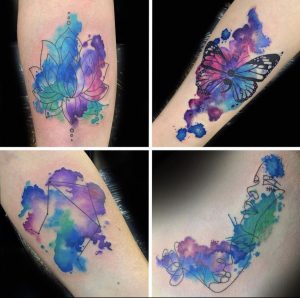Watercolour Tattoos
It is the darkest time of the year, and spring feels like a lifetime away, so we thought we’d treat ourselves to dreaming away in colour. Gaining in popularity faster than you can say #tattooinspo over the past decade, watercolour tattoos have become a style of their own. They have prompted discussions on whether or not they are style over longevity, but the artists that specialize in them say that they heal – and last – just as well as other genres, given that you care for them properly.
Thousands of years of tradition

As with anything when it comes to tattooing – motives, traditions, etc., – it is good to know a little bit of history about the style that you would like to get. Any artist proficient in a particular style or technique has practised for hours and hours off-skin before transferring their skills to a human canvas. To know something of what goes into that will allow you to appreciate your piece even more.
Also known as aquarelle, the art of watercolour painting goes back thousands of years, with the first examples being traced back to palaeolithic cave paintings. It was later used for Egyptian papyrus scrolls and Medieval illustrated manuscripts, before finding artistic fame during the Renaissance, when it was used to create an array of nature-related motives. It has also been prevalent in Chinese art since 4,000 BCE, and prevalent throughout history in Japan and Korea. This could explain why some of the most popular watercolour tattoo artists today are coming out of these parts of Asia.
What is known as the Golden Age of Watercolour was ushered in during the later 18th century, and many artists incorporated the technique into their avant-garde work during the 20th. Albrecht Dürer, William Blake, Elizabeth Murray and Vincent van Gogh are all notable Western artists within the style.
Skills from canvas to skin

The word watercolour refers to both the way in which it is painted and the artwork itself. It is done by mixing natural colour pigments with water-based solutions. Unlike the classical art form, tattoo artists don’t need any special ink to create watercolour tattoos. However, many of the skills applied to traditional watercolour paintings are also utilised by tattoo artists when transferring the technique to skin.
As watercolour tattoos began taking off in earnest at the beginning to the last decade, there has been a debate on whether they fade quicker than many other tattoo styles. The lack of lines and borders were thought to allow the tattoo to lose definition quicker.
Some artists have adopted thin, black outlining to their watercolour tattoos to stop this from happening. The lack of deep saturation has also been why some have questioned their longevity, although most artists today recognise that they can age with the same vibrancy as more intensely coloured pieces.

Protecting your piece
Meanwhile, all tattoos will fade to some degree – some faster, some over a longer period of time. As watercolour is so new, it is hard to say how they will actually look after 20 years. However, tried and tested methods such as keeping sunlight exposure to a minimum, choosing a location on the body that doesn’t get much friction, and most importantly, choosing a highly qualified artist that knows their stuff, will all go a long way to keeping those gorgeous colours bright and vivid for longer. So choose your dream motive and colour away.
